Behind The Eye; My Ancestors were Traders
By: Heri Kris (Artist and Curator)
Behind the eye is a headline in the Solo art exhibition of Khadir Supartini, which will be held in June 2023 at The Cultural Park of Jogjakarta. An art exhibition, featuring several two-dimensional and three-dimensional works. Behind the eye gives a prespective of what human eye can sense, and how the eye is capable of absorbing all the moments and objects which then became the artist’s inspiration for the work. Behind the eyes often stored many things that flowed to the brain and turn into thoughts and ideas of a human being. The eye is a the door for human interaction. How it decides which is good and bad, beautiful or not. It influences one’s soul, as well as in art (fine art). The eye plays an important role when an event is seen for the first time through the eyes and then put in the mind. It was from there, great works of artists were born through their sense of sight. In this case, Khadir Supartini emphasizes the importance of sight in the process of creating works of art.
Khadir Supartini is a young artist born in Sleman on December 13, 1988. I knew Khadir around 2009 when he and his fellow Sleman artists created a community for the purpose of joint exhibitions and then created a discussion forum on Art. 15 artists had already joined the forum and each month, it’s members presents their work for a joint discussion. Each work (painting) is analyzed from several sides. From it’s concept, technique, medium and creative process. After running for several years, their works were shown to be progressive and artistic. As a supervisor, I’m often involved in discussions related to their work. I know Khadir has a sociable personality and easily gets along with others. He has the willingness to work with high enthusiasm. There are alot of personal stories and his works. And after so many years, we both have grown to become close friends to share in his artistic process. Over time, Khadir Supartini’s paintings has developed quite nicely, uniquely and personally. Khadir’s life experiences continue to inspire his works.
My Ancestors were Traders
As of Arab descent, Arab countries were known to excel in trading strategies and most of the Middle East population traded various kinds of goods. His mother was also a trader in a traditional market in Jogjakarta. It’s inevitable that Khadir Supartini has good business instincts. Arab is known to be the birthplace of Islam. Trade is also well known. The Arab community had earned a living from trading far before the birth of Islam. As they did not possess natural resources that could be collected to meet their needs. However, Arab was always known to be a strategic location. Where trade routes connect East and West countries. This inspired Khadir in one of his paintings, “My ancestors were traders”
While concentrating on working in his studio, Khadir never forgets to accompany his mother to the traditional market to help out. His work is inspired by the vast social activities he witnesses in traditional markets. One of the things that caught his attention was the moment when traders were busy setting up their stand, while engaging in trade on the roadside Traditional market. Around the same time, young people can be seem returning home from enjoying night life on the same street. This sight inspired him to create a painting.
As an artist, Khadir keeps his spirits high in order to get maximum results. The Spirit or soul is required in creating fine art, as every individual artist has different personalities. Each individual personalities forms a self-character. In 2010, Khadir’s painting used a realist technique and contained many transgender figures posing sexually. These figures ressemble Middle Eastern people, with thick hair and sharp noses. It is possible that Khadir is trying to parodize something by conveying this form of expression of his soul in this painting. As a child of Arab descent, Khadir shows an image of someone open, free, and has a futuristic outlook. Rather than potraying a religious individual commonly found in Arab society. His visits to several Arab and European countries a few years ago have provided him experience and enlightenment such as his mindset about orthodox concepts to be more rational and secular.
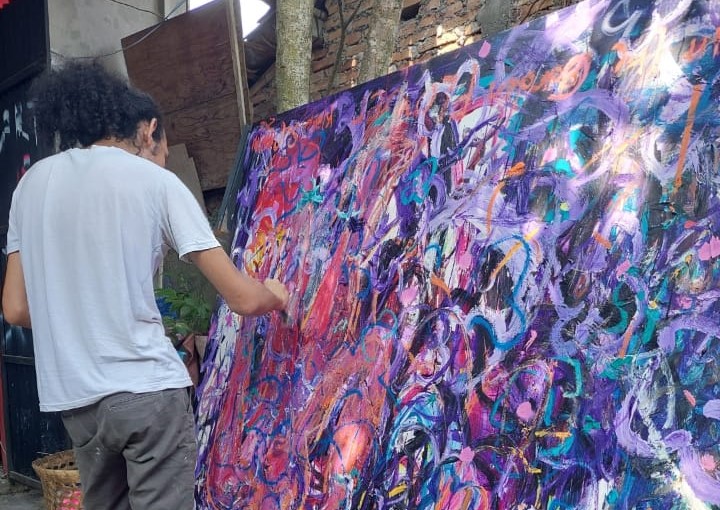
Expressionistic and Impulsive
During the process of developing his work, Khadir Supartini has applied several various experimental processes in his paintings. From paintings that are based on realist techniques combined with abstract strokes, then flow evolves to expressionistic and semi-abstract techniques. Expressionism is an art style which emerged from the west where objects and figures in paintings serves as a trigger for inspiration which are then expressed spontaneously by the artist according to the state of his soul. Flow, current emotions, moods, thoughts and feelings greatly influence the results of a work.
An expressionist painter uses emotional control associated with tragedy or other empirical experience to produce the work he wants, this is called “Pathos” or an emotional control. In literature, the term “Logos” represents more argument. But in art, it can take form of ideas packaged in etchings and images of forms that have semiotic meanings. Expressionistic art represents works that are actual in nature and have been distorted towards a certain atmosphere according to the moment that occurred at that time. Painting with expressionism style has two types, namely figurative and abstract. Paintings with figurative expressionism tend to distort reality with emotional effects. And abstract expressionism prioritizes pure expression without considering the shape figures that exist in nature. Like Khadir Supartini, he’s a person who is separate from others in terms of work, even though he’s an outgoing person. Expressionist works similar like those worked on by Khadir are different. As each painting reflects an artist’s personality. Compared to other painters, Khadir’s paintings contains unique and personal themes. This is often written about in psychological analysis by Sigmund Freud who considers that every person, especially artists, has internal and emotional aspects that carry imagination and fantasy personally. In acting impulsively, Khadir is much influenced by his subconscious mimd which appear as lines, images, brushstrokes and other details in paintings. According to Freud, the life of the soul has three levels of consciousness. Which are the conscious, preconscious and unconscious. In this case, the process from the sublime becomes an impulse that emerges into expressionistic works and is included in the preconscious category (a level of consciousness that becomes a bridge between conscious and unconscious). If we take a closer look at the history of western expressionism up to today’s contemporary expressionists, there have been many shifts in perception and form. As did Ferdinand Hodler (Switzerland, 1853-1918) and Vincent Van Gogh (Netherlands, 1853-1890). They were painters who battled against the establishment of western impressionism, where they were no longer compartmentalized in impressions of natural objects but rather processed ideas into the freedom of distortion and the artist’s inner psyche. Edvard Munch, born in Norway in 1863, was also one of the figures of expressionism whose works are quite famous, such as “The Scream” painted in 1893. One of the painters in the developing era of western expressionism was Max Beckmann, born in Leipzig, Germany, 1884 and died in 1950. The work of Max waw considered a prominent example in character of the “Neue Sachlichkeit” (new Objectivity), a movement distinguished by the rejection of expressionism and the rise of realism. Max Beckman’s work contains many elements of social criticism at that time period as in one of his works entitled “The Night”, oil on canvas which was made in 1918. In Indonesia, Affandi was known as the the maestro of expressionism. Born in 1907, and died in 1990 Affandi uses his hands as a technique to scratch the canvas when painting. The objects in Affandi’s paintings represent the spirit and emotions which are then put onto the canvas. The power of emotion in expressionist paintings will then be able to evoke the emotions of those who observe them. In contemporary painting, expressionist techniques are still sometimes used by artists today, where many contemporary ideas wish to be expressed spontaneously and expressionistically. Khadir often experiences anxiety in his life about things that can provoke ideas in his work. Such as his empathy for the traditional market people, who gets up early in the morning every day and works hard while everyone is still asleep. There are also works that are inspired by things that are enigmatic, cryptic and imaginary.
Khadir Supartini spends his daily life in Sleman, Special Region of Jogjakarta. Where he lives with his wife and mother. As an artist, he really admires artists with expressionistic works, where they gives a lot of influence in the development of his work. One of the European painters he admired was Martin Disler, born in Switzerland in 1949 and died in 1996. Martin Disler was a painter and sculptor who was expressionist and was naive enough to be called an avant-garde artist. Despite being a writer and draftsman, he was known to be mischievous and has an undisciplined character. He was expelled from school as a teenager. The strength of Martin Disler’s work lies in his ability to combine large and small rhythmic lines and spontaneous colors that overlap dramatically and poetically so that his works are nicknamed “Neue wilde” or a new and wild. Martin’s paintings are very direct, spontaneous and impulsive. The images that appear in his paintings are wild, unique and naive. There are several paintings by Martin Disler which give rise to texts as a semiotic confirmation of his work.
As an artist, Khadir Supartini is quite productive with his relatively large works. To build up his passion for work, Khadir often listens to his favorite music. From artists such as Deep Purple, Ac Dc, Nirvana, Sex Pistols, The Rolling Stones, Aerosmith and other classic rock music. He has a taste in 70s and 80s music. He felt that the music in that era was more original, timeless and very suitable to listen when working on his work. Just as Khadir did. One of his favorite classic rock albums successfully inspired one of his paintings.
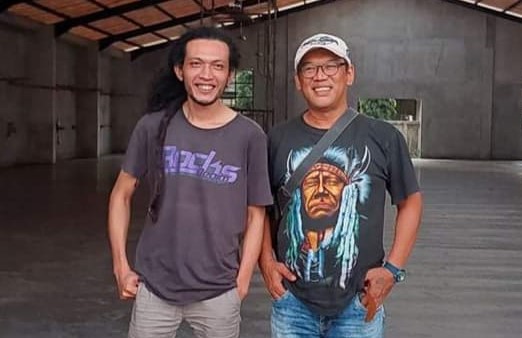
Alot of Khadir paintings are large in size. One of which is entitled “Sun never goes down”, 200X360cm, acrylic on canvas, 2023. The painting tells about how if the sun never sets and life goes on without stopping. An imagination that goes wild in ideas and crashes into normative logic. This expressionistic and impulsive painting expresses his subconsciousness when he remembers a dynamic of life which is quite disturbing to his mind. Apart from being expressionistic and impulsive, the work is also enigmatic as it holds mystery that is sometimes difficult for the audience to grasp. In contrast to paintings that are naturalistic or realistic, which tend to be more communicative and can clearly narrate objects. Khadir’s painting that I find interesting is entitled “Scene”, 300X200cm, acrylic on canvas, 2023. The painting is done with a dark background and scattered wild lines but is dramatic and poetic with strong colors. According to the Khadir, the painting has a landscape theme, but the landscape depicted here is not a landscape, but a mindscape. For an abstract or expressionist painter, “mind scape” is a space contained in the artist’s mind, where there are various components of the ideas worked on in the work. In the painting above, one can really feel how Khadir’s emotions and feelings are applied into the painting in form of dynamic and rhythmic lines. It also shows strokes between the small, medium and large lines that cross each other and dance in rhythm. Another painting by Khadir entitled “Head for feet”,145X185cm, acrylic on canvas,2022. The painting was inspired by the Javanese philosophy which reads “sikil dienggo sirah, sirah dienggo sikil” (head for head, head for feet) where a person who always works hard is often likened to that a person is like a head made into legs and vice versa to overcome work that takes up a lot of time and energy. A painting depicting two figurines whose feet are in the form of heads with the composition faced from each other, upside down. In this painting, it seems that Khadir attempted to present the Javanese philosophy of life from another prespective. Semiotically, a painting depicting a leg in the shape of a head is a marker of philosophy that is able to interpret symbolically about the Javanese people who like to work hard. Khadir’s semiotic paintings are also found in a work entitled “Rabbit on the wire”, 200X400cm, oil on canvas, 2022. The painting depicts a fence which is usually made of wire with objects filling the entire canvas. Rabbits and fences as the subject matter are not described realistically but are just an empty wire fence filled with nothing.
It has been truly unique to observe Khadir Supartini’s works with themes that show personality. It’s as if we are swept away in the emotions and wild expressions that are sometimes mysterious. The exhibition “Behind the eye” invites us to understand that the eye is an important sense that sees many things. The eye can catch signs in life that can disturb a person’s psyche. Eyes can respond to all external events which shape a person’s character. With our eyes, we can work creatively and innovatively. Congratulations on the exhibition, Khadir. I wish you all the success.
Jogjakarta, 8 May 2023
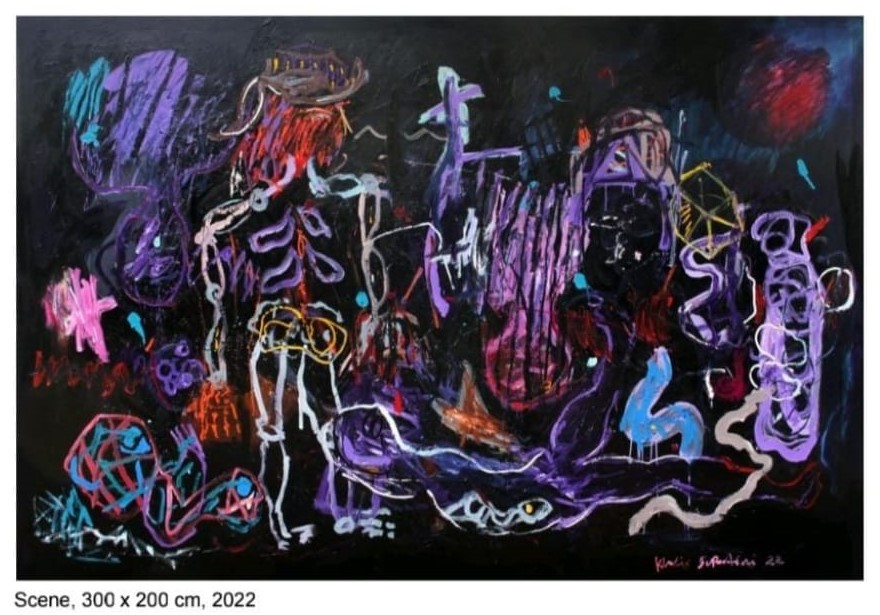

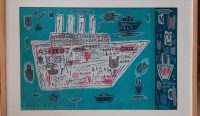



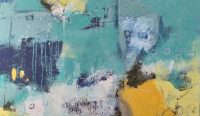
Leave a Reply